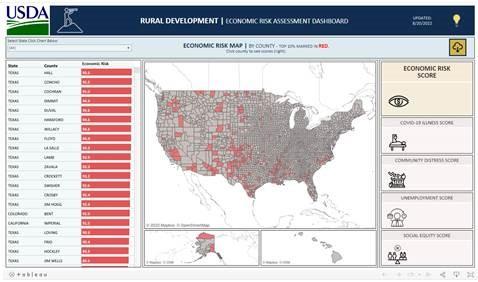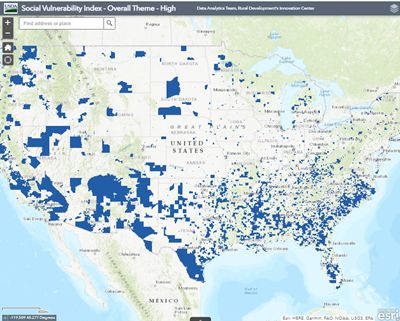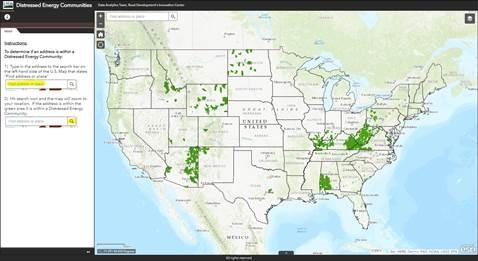Does my project qualify for priority points?
To help with your understanding of the Priorities and who will qualify, we offer the following information:
Creating More and Better Markets
Assisting rural communities to recover economically through more and better market opportunities through improved infrastructure.
Priority Points: Applicants receive priority points if the project is located in or serving one of the top 10% of counties or county equivalents based upon county risk score in the United States. Please use the Economic Risk Assessment Dashboard to determine if the county your project serves qualifies for priority points. The top 10% of counties or county equivalents are highlighted in red on the dashboard.
For additional information on data sources used for this priority determination, please download the Data Sources for Rural Development Priorities document.
Note: US Territories would obtain points by using local data regarding how economic risk factors in the dashboard have impacted proposed project area.
Map Helpful hints:
- The optimal web browsers for this map is Microsoft Edge or Chrome. This map will not function properly in Internet Explorer.
- To see county and county names zoom into the location or put the name of the location into the search bar and they will then be visible.
Advancing Racial Justice, Placed-Based Equity, and Opportunity
Ensuring all rural residents have equitable access to RD programs and benefits from RD funded projects.
This priority aligns with the Executive Order on Advancing Racial Equity and Support for Underserved Communities Through the Federal Government
Priority Points: Applicant receives priority points if the project is located in or serving a community with score 0.75 or above on the CDC Social Vulnerability Index. Please use Social Vulnerability Index Map to look up map or list to determine if your project qualifies for priority points.
For additional information on data sources used for this priority determination, please download the Data Sources for Rural Development Priorities document.
Note: US Territories would obtain points by using local data to demonstrate the social vulnerability of the proposed project area.
Map Helpful hints:
- The optimal web browsers for this map is Microsoft Edge or Chrome. This map will not function properly in Internet Explorer.
- To see county and county names zoom into the location or put the name of the location into the search bar and they will then be visible.
Addressing Climate Change and Environmental Justice
NOTE: The below priority points do not apply to the Rural Energy for America Program (REAP) as covered under the Inflation Reduction Act (IRA). To determine priority points for REAP IRA, use the look-up map of Distressed and Disadvantaged Communities.
Reducing climate pollution and increasing resilience to the impacts of climate change through economic support to rural communities.
Priority will be given to proposals that address climate crisis through projects that:
- reduce climate pollution; promote energy efficiency and clean transportation; increase renewable energy production; revitalize recreation economies and the economies of coal, oil and gas, and power plant communities; increase resilience to the impacts of climate change; protect the public; and conserve our lands, waters, and biodiversity or
- spur well-paying union jobs and economic growth, especially through innovation, commercialization, deployment of clean energy technologies and infrastructure or
- advance environmental justice in historically marginalized and other communities overburdened by pollution where economic hurdles include underinvestment in housing, transportation, water, wastewater, and clean energy infrastructure, as well as workforce development and health care needs.
Priority Points: Applicant can receive priority points through one of two options listed below:
- Option 1: Applicants will receive points if the project is located in or serving an energy community (fossil fuel dependent - coal, oil and gas, and power plant communities) whose economic well-being ranks in the most distressed tier of the Distressed Communities Index. The energy community list is defined by the Report to the President on Empowering Workers Through Revitalizing Energy Communities: https://netl.doe.gov/IWGInitialReport The Distressed Communities Index provides a score between 1-100 for every community at the zip code level. The most distressed tier of the index are those communities with a score over 80. Please use look up map or list to determine if your project qualifies for priority points.
- Option 2: Applicants will receive points by demonstrating through written narrative how proposed climate-impact projects improve the livelihoods of community residents and meet pollution mitigation or clean energy goals.
For additional information on data sources used for this priority determination, please download the Data Sources for Rural Development Priorities document.
Note: US Territories would obtain points through option 1 by using local data to demonstrate that the proposed project area has a high concentration of fossil fuel-employment. Under the Distressed Communities Index, all US Territories are considered Distressed Communities.
Map Helpful hints:
- The optimal web browsers for this map is Microsoft Edge or Chrome. This map will not function properly in Internet Explorer.
- To see county and county names zoom into the location or put the name of the location into the search bar and they will then be visible.
Contact Us
If you have questions about determining qualification for priority points, please email USDA.RD.DATA@usda.gov



